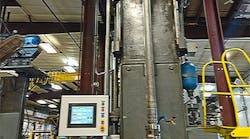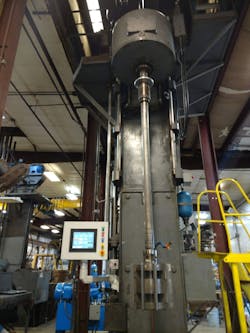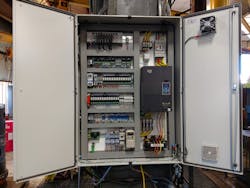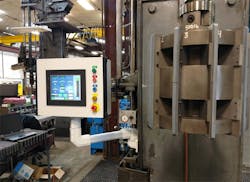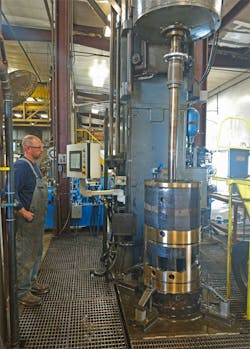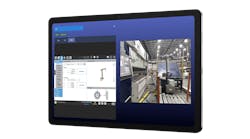Exline Leasing repairs and rebuilds machine tools and industrial machinery. The company was asked to upgrade the electrical and hydraulic system on a 1936 model 4030 Barnes cylinder honing machine which hones large cylinders used in the natural gas industry. Aside from the electrical system, which had been converted from dc voltage to ac voltage back in the 1980s, little had changed since the 1930s with respect to the cumbersome original automation system design.
The goal was to completely replace the automation system with a modern controller, operator interface, variable frequency drive and motor controls from AutomationDirect. Significant power distribution, wiring and related hardware upgrades using components from AutomationDirect would also be required.
Company and machine background
Exline, located in Salina, Kansas, was established more than 140 years ago when Robert Warren Exline left Ohio and migrated to Abilene, Kansas, to set up his blacksmith shop. Beginning with a forge and anvil under a shade tree in 1872, Exline has grown to become a large repair and manufacturing company servicing the gas-compression, power-generation and plastic-mixing industries. Exline Leasing is a division of Exline and handles the repairs, upgrades and maintenance for the machines, equipment and assets within the company.
For this project, Exline started with a long list of machine issues and corresponding tasks. Based on the information collected, several quotes were obtained from outside contractors. However, when the quotes were reviewed, it was determined that the maintenance department could successfully complete the project in-house for less than 30% of the lowest price quoted, so the decision was made to do the work with Exline personnel.
The large vertical honing machine is more than 31 ft tall and weighs in at approximately 24,000 lb (Figure 1). The original machine was built more than 80 years ago to hone 17.5-in diameter by 5-ft-long diesel engine sleeves. The machine’s current capabilities, after completion of this upgrade project, include a vertical spindle travel of up to 90 inches using a 25-hp hydraulic pump and cylinder, with a 40-hp spindle rotation motor providing a maximum 30-in honing diameter.
Figure 1: This honing machine was built in 1936 and will continue to operate effectively for many years after the complete replacement of the original control system.
(Source: Exline)
During the normal operation sequence, the table brings the cylinder into position under the honing head. Once it’s in position, the operator initiates honing by holding the start button for three seconds to start the automatic honing cycle. The honing head then reciprocates vertically for the programmed number of strokes within the programmed travel limits. When the stroke counter has reached the preset value, the honing head withdraws out of the cylinder to the programmed withdraw position.
Addressing issues
Many problems needed to be addressed with respect to machine operation and hardware. The original controls provided limited functionality. One problem was that the operator was not able to instantly and accurately reverse the reciprocation direction during the honing cycle. This function is required to address a bore that is not perfectly straight and allows for extra material to be removed.
Part changeover was another issue. An operator needed to climb up and down an often-slippery ladder on the side of the machine to adjust the travel limit switches for each type of cylinder. Operators also needed an indicator to highlight the current vertical travel limits and position of the spindle as an operational aid during the machining process.
On the hardware side, the antique machine had both hydraulic and electrical issues. The hydraulic system needed to be completely replaced to eliminate the reservoir inside the machine casting, which was causing contamination problems due to its open design.
Electrically, all the wiring and terminal connections needed to be replaced. Due to its age, there were reliability problems that frequently required extensive troubleshooting to find loose and/or shorted connections.
The original design had fixed gear ratios, making it hard to get the proper cross hatch during finish honing. Variable-speed control of the spindle was required to address this issue, along with the display of additional machine process information.
Providing solutions
One of the original problems was how to make the travel limit switches easily adjustable from the floor without using a ladder. The original design required the operator to climb up the side of the machine to adjust the travel limits for each type of cylinder. One idea was to motorize the travel limits so they could be adjusted from the floor, but instead it was decided to use encoders and an AutomationDirect Productivity2000 PLC (P2000) with a high-speed input module to handle positioning (Figure 2). Exline decided to use the P2000 PLC to automate this and other aspects of machine operation because it is very cost-effective and has free software that is intuitive and easy to use.
Figure 2: Modernizing the machine control system required the addition of a PLC and an ac high-performance drive.
(Source: Exline)
Another requirement was improved control of the automated honing sequence and spindle positioning. The spindle vertical motion was controlled with an hydraulic cylinder and a manual flow-control valve, but it is now controlled automatically by the PLC by switching an hydraulic valve. The motion is monitored by an encoder feeding the position back to the PLC, which controls the position based on multiple position setpoints programmed using the human-machine interface (HMI) color touch screen.
These upgrades improved spindle position monitoring and control to a tenth of an inch, whereas before only the end-of-travel limit switches were provided. This monitoring improved the final product by making short-stroking possible. For example, if the cylinder bore is .001 inches smaller at the top than it is at the bottom, the operator can then short-stroke the honing head in the upper half of the cylinder to make the bore concentric again. When the operator completes the short-stroke cycle, the operator can release the short-stroke button, and the hone will resume its normal full-stroke function again without interrupting the cycle.
Exline found the PLC easy to work with and especially liked the display on the front of each I/O module showing live information about the connected components. This was very helpful in setting up the analog input sensors because personnel knew right away if they were outputting the correct signal before it was altered by scaling within the PLC.
The ZIPlink PLC I/O cables and terminal-block modules provided significant time saving when the control panel was assembled and reduced the risk of crossed wires among components. The additional terminals on the new ZIPlink relay boards were also helpful because they simplified jumpering of common wires and eliminated having to insert two wires into one terminal slot.
HMI improves automation
A C-more EA9 series 12-in color touch screen HMI from AutomationDirect was connected to the PLC through an Ethernet cable (Figure 3). Exline decided to use this HMI because it was priced right, the software was easy to use, and it had more features compared to other brands. A common USB cable is used for programming and initial setup, and the software has an extensive feature set to produce professional-looking results with minimal configuration effort required by the end user.
Figure 3: The addition of a touchscreen HMI provided operators with the required control and monitoring functions to improve machine operation.
(Source: Exline)
Using the HMI, an operator can simply type in the required position if changes are needed. The operator can also program the number of honing strokes to run before the machine automatically withdraws from the cylinder. To simplify part changes, the HMI has recipe functions to automatically fill in the stroke limits, stroke count and spindle speed parameters. These and other HMI functions made it much easier for new operators to learn how to run the machine.
The HMI displays other information such as process pressures, spindle rpm, spindle load percent, reciprocation rate, traverse position and total strokes. The addition of analog input modules and AutomationDirect ProSense pressure transmitters enabled indication of transmission, stone (the force the honing stones apply to the inside diameter of the cylinder), hydraulic and air pressure. This gave the operator much more information about the process and allowed maintenance to add alarms into the ladder logic of the PLC, improving safety and preventing damage to the machine.
Powerful speed control
The automation control system solution eliminated a honing problem by varying the spindle speed to obtain the proper crosshatch pattern during the finishing process. This required the addition of a new 50-hp DURApulse GS4 series ac high-performance drive from AutomationDirect to operate the 40-hp spindle rotation motor, which provides the power needed to rotate the large diameter honing tool.
Although Ethernet and serial Modbus RTU/ASCII communication is available between the PLC and drive, simpler communication was sufficient, with a 4-20 mA analog output speed signal from the PLC sent to the drive to control rpm, allowing on-the-fly changes using the HMI. The rotational speed is controlled by this open-loop speed signal with the required degree of accuracy, with no need for an encoder to close the control loop.
Programming particulars
Using encoder positioning for spindle control, instead of relying on discrete limit switches for spindle vertical direction reversal, expanded control options and allowed for many functions that would not have been available without PLC control. The choice of the hardware and programming platform made adding the encoder to the automation system program very simple, and it only took a few minutes to configure. The programming simply required clicking on the picture of the high-speed input module in the hardware configuration menu within the AutomationDirect Productivity Suite software and filling in the required information. Once configured, end-of-travel position limits were easily programmed using the comparator functions in the software.
While the original control system was very limited, the new PLC allowed the addition of many functions that were not part of the original design. For example, code was added to prevent the head from traveling lower than 70 inches when the table is out to protect the spindle hydraulic cylinder. Another example was the addition of adjustable soft limits to shut down the machine if the spindle moved too far past the designated travel position. Alarms were also added to quickly notify operators of any malfunctions, further improving safety and protecting the machine.
The task manger menu within Productivity Suite was used to simplify coding by breaking it down into manageable sections or tasks. Depending on the task, the PLC could be programmed to run on the first scan, every scan, every second, only when called upon or not at all. This saved a lot of time during troubleshooting and allowed efficient use of processor scan time.
The recipe screen allows operators to set up all the parameters for a certain type of cylinder at the touch of a button. This automatically sets the upper and lower stroke limits, withdraw position, number of strokes completed and initial spindle speed. The HMI also provides the operator with all the necessary setup information to properly fixture the cylinder and complete the honing process with the proper finish.
Results
The electrical installation went well and there were no major issues. The electrical startup also proceeded as planned, with the only delay being the addition of extra functions requested by the operators.
The control system upgrade makes machine operation much easier by providing access to manual functions and by easing product selection and changeover. With the additional process information available to the operators via the HMI, they have been able to speed up the process and complete finished cylinders in a much shorter time. In some cases, the honing time was reduced by nearly 75% (Figure 4).
Figure 4: Replacing the automation and electrical system resulted in a 75% reduction in honing time.
(Source: Exline)
The electrical and automation system upgrade made it much more cost-effective and quicker to machine or repair large cylinders, improving the bottom line for both Exline and its oil-and-gas customers.
